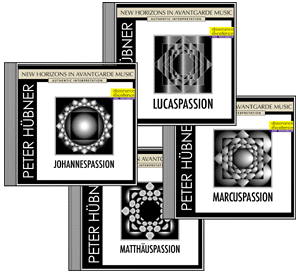
PETER
HÜBNER
FOUR PASSIONS
Great
Soloists
Great Philharmonic Orchestra
Great Percussion Orchestra
Elektronic Instruments, Organ
label: Dissonance in Excellence
total playing time: 4h 37’14”
For
more Information and if you want
to listen please visit:

In today’s
times, many people are confused by the aspect of perfection. At an automobile
fair, many are astonished about the enormous technology of a car manufacturer.
But nobody is astonished about the incomparably enormous technology which
finds its expression in the fly’s eye whose owner is just at that moment
sitting on the exterior mirror, and is seemingly rubbing her hands and/or
her tiny forelegs.
In contrast to the unnatural, the natural distinguishes itself by simplicity,
by inconspicuousness, by discreetness. The complexity of an elephant’s
harmonious movements are hardly noticed by the modern observer. It is the
other way round with the comparatively primitive behaviour as a driver during
the Formula 1 Race – probably because the drivers there generate higher
turnovers and/or earn more than an elephant.
Modern industrial societies have a price to pay for this sort of blindness
towards the natural, which shows in form of diseases, disasters, catastrophes,
depressions and many other things, and this blindness does not make an exception
for the whole area of music.
Atonal music, also my own from earlier times, at first glance, seems to be
intelligent, interesting, complicated and exciting to the restricted spirit
of our scientific technological age. And perfectly naturally structured music
seems to the same people to be boring, simple, uninteresting, music to fall
asleep by. But this problem is not a problem of music, but a problem of development
of the listener and the music creator.
JOURNALIST:
Herr Hübner, what is harmony and what is disharmony?
PETER HÜBNER: Musically, disharmony
is the deviation from the natural order of the laws of harmony of the microcosm
of music.
In contrast, harmony is the order used in the composition of the laws of harmony
of the microcosm of music.
Harmony is that which a plain human being feels to be harmonious. It is a
mistake to believe that being able to feel harmony is a matter of practice.
The composers of disharmonious music always point to Beethoven or Wagner to
say they, too, needed a long time to find recognition. But this comparison
is not correct.
Regarding tonal harmony in their music, they never had difficulties –
they couldn’t have – well, that is, disregarding Wagner’s Tristan.
Concerning Beethoven, the experts were locked in dispute with him, because
he brought the emotional into music – today usually described as “dynamics”.
Bach was still of the opinion that manipulation of volume was only aimed at
superficially manipulating feelings, and from a purely musical point of view
didn’t mean anything at all – instead even distracted from the purely
musical.
Wagner’s disputes with the experts at the time, were about his annoyance
that they didn’t know the first thing about music – the same also
applied to the interpreters.
But it was never about the aspect of harmony. Harmonical music is a matter
which is scientifically objectively verifiable, and what is felt to be harmonious
or not is, across the cultures, not a question of taste or of education, but
is solely based on the fact that the biological system of human beings is
harmonically structured, and that here especially the ear is physiologically
aimed at the knowledge and preference of natural, harmonical structures. Here,
with regard to the medical effect, the biological systems are equipped with
automatic amplifying and muffling mechanisms, that is more or less, with sympathy
and antipathy mechanisms.
An analysis of the compositional structure can, of course, also provide information
on whether it is harmonious or disharmonious music. Such musicologically harmonical
knowledge is very important if you want to judge the quality of music. The
microcosm of music reveals to us a world of music which does not know disharmony.
The nature of a tone is made in such a way that, when it is made as an integrated
whole – i.e. when it is a natural unity – it develops according
to the laws of harmony of the microcosm of music.
There are mock tones which are in reality artificially created mixtures of
tones which are mixed together from the outside – be it with mechanical
or electronic musical instruments. Such “tones” have no natural
development according to the laws of harmony of the microcosm of music.
JOURNALIST: What is dissonance?
PETER HÜBNER: Dissonance – like
disharmony – is recognised spontaneously by the plain human being. The
sound physically disturbs him, he physically feels unwell. Fundamentally,
what the listener perceives as dissonance, is also part of the harmonical,
but in the microcosm of music, this part is pushed far away by nature into
the hardly audible and right into the inaudible.
<< >>
© AAR EDITION INTERNATIONAL 2001